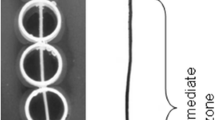Abstract
The objective of this study was to identify the sites of H-ion exudation and Fe(III) reduction along both inoculated and non-inoculated roots of A7 and T203 soybeans. A split-root system was used in which half the roots of each plant were inoculated and actively fixing nitrogen and the other half were not. Expectedly, the Fe-stress response was strong on both sides of the split-root system in the +N-Fe treatment of variety A7 (inactive nodules) but not of variety T203. The Fe-stress response of A7 was enhanced by the presence of active nodules. Variety T203 is Fe inefficient and normally fails to produce any Fe-stress response, but in the absence of nitrogen and iron (−N−Fe), inoculated roots responded to Fe stress with exudation of both H-ions and reductants. Intact split-root systems were embedded in agar to determine the location of H-ion exudation and Fe(III) reduction. On the inoculated side of the −N−Fe and −N+Fe treatments (active nodules) of both soybean varieties, H-ion production was associated mainly with the active nodules. However, quantities of H-ion release were much greater under Fe stress (−N−Fe) than with adequate Fe (−N+Fe). Reduction of Fe(III) to Fe(II) was found only on the nodulated side with T203, but on both sides with A7. In variety T203 the Fe reduction was associated with younger roots located just below the nodule clusters on the inoculated side of the −N treatments. Active nodules appear to play a key role in the Fe-deficiency stress response of T203 soybean.
Similar content being viewed by others
References
Ambler J E, Brown J C and Gauch H G 1971 Sites of iron reduction in soybean plants. Agron. J. 63, 95–97.
Brown J C 1978 Mechanism of iron-uptake by plants. Plant Cell Environ. 1, 249–257.
Gibson A H 1980 Methods for legumes in glasshouses and controlled environment cabinets. In Methods for Evaluating Biological Nitrogen Fixation. Ed. F JBergersen. pp 139–184. John Wiley and Sons, New York.
Jolley V D, Brown J C, Davis T D and Walser R H 1986a Increased Fe-efficiency in soybeans through plant breeding related to increased response to Fe-deficiency stress. I. Iron stress response. J. Plant Nutr. 9, 373–386.
Jolley V D, Brown J C, Davis T D and Walser R H 1986b Increased Fe-efficiency in soybeans through plant breeding related to increased response to Fe-deficiency stress. II. Mineral nutrition. J. Plant Nutr. 9, 387–396.
Marschner H, Römheld V and Ossenberg-Neuhaus H 1982 Rapid method for measuring changes in pH and reducing process along roots of intact plants. Z. Pflanzenphysiol. 105, 407–416.
Römheld V and Marschner H 1984 Plant-induced pH changes in the rhizosphere of ‘Fe-efficient’ and ‘Fe-inefficient’ soybean and corn cultivars. J. Plant Nutr. 7, 623–630.
Römheld V, Muller C and Marschner H 1984 Localization and capacity of proton pumps in roots of intact sunflower plants. Plant Physiol. 76, 603–606.
Singleton P W 1983 A split-root growth system for evaluating the effect of salinity on components of the soybean Rhizobium japonicum symbiosis. Crop Sci. 23, 259–262.
Soerensen K U, Terry R E, Jolley V D, Brown J C and Vargas M E 1988 The interaction of iron-stress response and root nodules in iron-efficient and-inefficient soybeans. J. Plant Nutr. 11, 853–862.
Soerensen K U, Terry R E, Jolley V D and Brown J C 1989 Iron-stress response of inoculated and non-inoculated roots of an iron inefficient soybean cultivar in a split-root design. J. Plant Nutr. 12, 437–447.
Terry R E, Hartzook A, Jolley V D and Brown J C 1988 Interactions of iron nutrition and symbiotic nitrogen fixation in peanuts. J. Plant Nutr. 11, 811–820.
Weaver R W and Frederick L R 1982 Rhizobium pp 1043–1070. In Methods of Soil Analysis. Part 2. Chemical and Microbiological Properties. Ed. A L Page. Agronomy No. 9.
Author information
Authors and Affiliations
Rights and permissions
About this article
Cite this article
Terry, R.E., Soerensen, K.U., Von Jolley, D. et al. The role of active Bradyrhizobium japonicum in iron stress response of soybeans. Plant Soil 130, 225–230 (1991). https://doi.org/10.1007/BF00011877
Issue Date:
DOI: https://doi.org/10.1007/BF00011877




